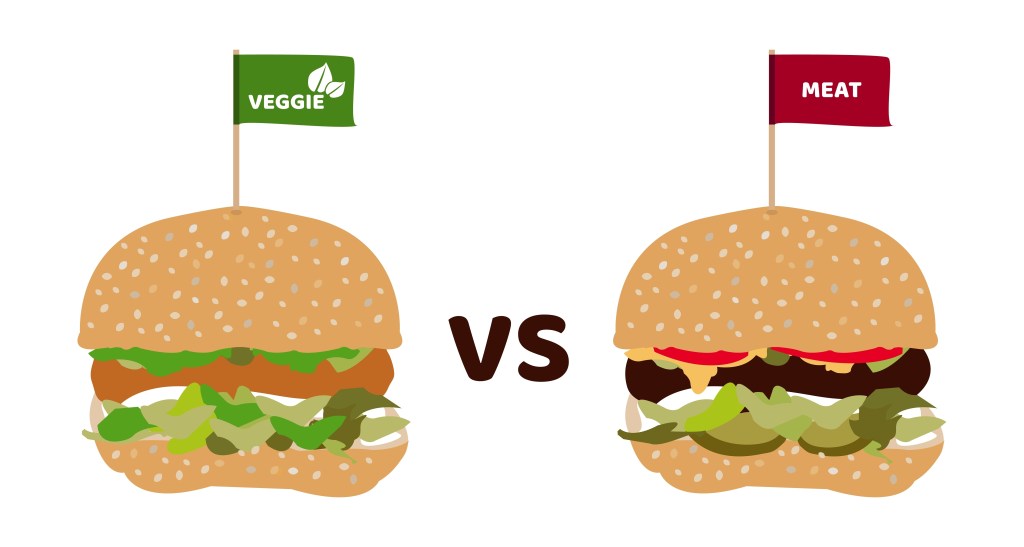At a glance
Plant-based meats are popular alternatives to animal protein, often chosen for ethical or environmental reasons. However, most of these products are ultra-processed and contain potentially harmful additives, refined carbohydrates, seed oils, and allergens. In contrast, whole-food plant-based proteins, such as tempeh, nuts, and tofu, provide a more nutritious option for meeting the protein needs of vegans and vegetarians.
Plant-based meats are popular alternatives for vegetarians and vegans, often chosen due to concerns about animal welfare and environmental impacts. But is plant-based meat healthy?
No, most plant-based meat products are ultra-processed and contain harmful seed oils and refined carbohydrates, which can disrupt normal metabolic function and cause inflammation.
Discover the difference between plant-based and animal meat and explore the best vegetarian protein options.
What is plant-based meat?
Plant-based meat, or plant-based meat analogs (PBMAs), serve as substitutes for traditional meats such as pork, beef, and poultry.
Fake meats are manufactured to achieve a similar appearance, texture, mouthfeel, and taste to real meats, including bacon, meatballs, burger patties, chicken filets, and ground beef.
Plant-based proteins appeal to vegetarians and vegans who are concerned about animal welfare, perceived risks associated with meat consumption, and the environmental effects of industrial farming.
Watch the video below to learn why plant-based meats aren’t sustainable.
Is plant-based meat healthy?
Although consuming more plant-based foods is generally linked to better health, fake meat products are heavily refined, often contain food allergens, and are packed with carbohydrates and sugars.
Due to their extensive processing, these products have low nutritional value and may contain harmful ingredients, making them anything but health-conscious choices.
Here are three reasons plant-based meats aren’t considered healthy.
1. Ultra-processed ingredients
Many plant-based meat substitutes contain ultra-processed ingredients, including chemical fillers, artificial colorings and flavorings, and additives such as carrageenan and methylcellulose, which are bulking agents.
Though these food additives give plant-based meats a more realistic appearance and texture, they’re linked to several chronic diseases, especially those associated with poor digestive health.
A study published in Comprehensive Reviews in Food Science and Food Safety found that food-grade carrageenan has adverse effects on gastrointestinal health by altering the composition of the gut microbiome.1
In addition, carrageenan is the most common food additive associated with gut inflammation, bloating, irritable bowel syndrome (IBS), and food allergies.
Additionally, synthetic food dyes and flavors, which are often derived from petroleum-based chemicals, may increase the risk of developmental and behavioral issues in children, cancer, and DNA damage.
2. Food allergens
Common ingredients in plant-based meat alternatives include soy, wheat protein, corn, and seed oils, such as sunflower or canola oil, all of which have been found to trigger inflammation within the intestinal lining.
Gut inflammation can lead to intestinal permeability or leaky gut, which allows the influx of undigested food particles and environmental toxins into the bloodstream. This can trigger systemic inflammation, allergies, and food sensitivities, as well as poor cognition and mental health, including anxiety and depression.
In addition, the majority of crops used in fake meats are genetically modified (GMO) or exposed to GMO toxins, such as glyphosate, which can end up in the final food products.
Exposure to glyphosate, a chemical herbicide, has been linked to an increased risk of cancer, liver and kidney damage, fertility problems, and digestive issues.
3. Carbohydrates and sugar
Meat alternatives are often made with refined carbohydrates, including added sugars, cultured dextrose, and maltodextrin.
These ingredients are used to improve texture, enhance flavor, and extend shelf life, but they can contribute to a higher glycemic index (GI) and reduced nutritional value.
Maltodextrin, widely known as modified food starch, gives plant-based meats a thicker consistency. However, it’s similar in structure to sugar and can contribute to significant blood sugar fluctuations linked to weight gain, poor metabolic health, and energy crashes.
“Maltodextrin has a higher GI than cane sugar,” explains Dr. Berg. “Regularly consuming modified food starch can contribute to poor metabolic health, including insulin resistance.”
Insulin resistance is a serious metabolic imbalance that impairs the body’s ability to process and regulate blood sugar, which increases the risk of type 2 diabetes, obesity, high blood pressure, and cardiovascular disease.

Plant-based meat vs. regular meat
Many believe plant-based products are healthier than animal meats. However, processed foods, even plant-based options, have been shown to have a more detrimental impact on health outcomes than minimally processed whole foods.
Here’s how plant-based meat substitutes compare to real meat.
Nutritional value
Meat alternatives are designed to have a similar protein profile to the animal-based meats they mimic.
However, in addition to protein, they also contain additives and fillers, resulting in a very different nutritional value compared to animal meat products.
According the U.S. Department of Agriculture (USDA), one Morningstar Farms veggie burger contains:2
- 118 calories
- 3.7 g fat
- 12 g protein
- 9.2 g total carbohydrates
- 3 g fiber
- 6.2 g net carbs
Although these veggie burgers offer small amounts of nutrients, including calcium, phosphorus, and potassium, they’re manufactured with nearly 30 highly processed ingredients, including wheat gluten, corn oil, cornstarch, and sugar.
In contrast, real meat contains no fillers and retains its natural nutrients without the need for extensive processing.
Here’s the nutritional value of one four-ounce (113-gram) beef patty:
- 290 calories
- 23 g fat
- 19 g protein
- 0 g total carbs
Beef is an exceptional source of health-promoting saturated fat and several essential nutrients, including B vitamins, magnesium, phosphorus, potassium, selenium, and zinc.
In addition, animal-derived protein and iron are highly bioavailable, which means they’re more readily absorbed and utilized by the body than plant sources.
This is an important consideration for vegetarians and vegans who are commonly deficient in nutrients, such as vitamin B12, vitamin D3, and heme iron, which can only be obtained from animal sources.

Health impacts
Plant-based products are gaining popularity, largely driven by unfounded concerns about the potential health risks of meat consumption, particularly its association with elevated cholesterol levels and increased cardiometabolic risks.
However, evidence found that processed plant foods increase the risk of heart disease and stroke significantly more than a whole-food plant or animal-based diet.
The study, published in The Lancet, concludes, “Plant-sourced ultra-processed foods (UPF) consumption was associated with a 5 percent increased risk of cardiovascular disease and a 12 percent higher risk of mortality.”3
Additionally, type 2 diabetics are typically recommended to reduce red meat and increase plant food consumption, prompting some to opt for meat alternatives for their convenience.
However, research published in The American Journal of Clinical Nutrition found that an omnivorous animal-based meat diet resulted in greater glycemic control than those following a PBMA diet.4
The authors suggest that this is likely due to the high sugar and carbohydrate content of meat alternatives and highlight that those who regularly consume PBMAs don’t display better cardiometabolic health compared to meat eaters.

The best vegetarian protein options
Relying on plant-based meat alternatives for daily protein intake may negatively impact digestive health, blood sugar control, and insulin balance.
Therefore, those following a plant-based diet may benefit from opting for whole-food protein sources to avoid the detrimental impacts of fake meats on metabolic and cardiovascular outcomes.
Here are some of the best vegetarian protein options:
- Tempeh: 15 g per half cup
- Nuts: 14 g per half cup
- Tofu: 10 g per half cup
- Sunflower seeds: 6 g per half cup
- Pumpkin seeds: 6 g per half cup
- Chia seeds: 5 g per 1 ounce
- Almond butter: 3.4 g per tablespoon
- Hemp: 3 g per tablespoon
- Hummus: 1.2 g per tablespoon
The recommended dietary allowance (RDA) of protein for the average adult is approximately 0.8 grams per kilogram of body weight.
However, those who exercise or recover from surgery may require between 1 and 2 grams of protein per kilogram to support optimal muscle protein synthesis and recovery.
Key takeaways
- Most plant-based meat products are ultra-processed and contain synthetic additives, seed oils, and refined carbs, which can contribute to inflammation and metabolic issues.
- Regular consumption of fake meats is linked to poor gut health, insulin resistance, and an increased risk of heart disease and obesity.
- Animal-based meat offers highly bioavailable protein as well as various essential nutrients, including vitamin B12, iron, and zinc.
- Whole-food plant proteins, such as tempeh, nuts, seeds, and tofu, offer a more nutrient-dense alternative for vegan and vegetarian diets.
FAQ
1. What are the disadvantages of plant-based meat?
Plant-based meats are ultra-processed foods that have been linked to an increased risk of obesity, diabetes, and cardiovascular disease. Many brands also contain artificial ingredients, sugars, and modified food starches, which contribute to blood sugar fluctuations and poor metabolic health.
Additionally, vegetarians and vegans are commonly deficient in essential nutrients, such as vitamin B12, vitamin D3, and heme iron, which can only be obtained from animal sources.
2. Is plant-based meat healthy?
No, plant-based meat doesn’t offer health benefits. These products are typically produced using processed ingredients, including seed oils, starches, and sugars, which can contribute to digestive disorders, hormonal imbalances, and systemic inflammation.
In addition, individuals regularly consuming plant-based meats are at greater risk of heart disease and overall mortality compared to meat eaters.
3. Is it okay to eat plant-based meat every day?
No, eating plant-based meat daily isn’t recommended. Similar to other ultra-processed food products, meat alternatives are highly refined and associated with an increased risk of cardiovascular disease and poor metabolic health.
4. Is plant-based meat good for weight loss?
No, eliminating real meat from your diet isn’t the best way to lose weight. Many meat alternatives are high in carbohydrates and seed oils, which disrupt metabolic processes and can make it more challenging to achieve your weight loss goals.
In contrast, real meat offers highly bioavailable protein and healthy fats, which promote satiety and help regulate appetite, making it easier to support sustainable weight loss.
5. Is plant-based meat ultra-processed?
Yes, plant-based meat is an ultra-processed food and must undergo several processing techniques to mimic the appearance, texture, flavor, and protein profile of real meat. In addition, fake meats often contain chemical additives, binding agents, bulking agents, and colorings.
6. Is tofu good for you?
Yes, tofu can be healthy if made from fermented, non-GMO soy. Genetically modified soy is typically treated with glyphosate, a herbicide linked to cancer, organ damage, and metabolic syndrome.
Additionally, tofu is a good source of protein, offering ten grams per half cup.
Sources
- https://pubmed.ncbi.nlm.nih.gov/34146449/ ?
- https://fdc.nal.usda.gov/food-details/751738/nutrients ?
- https://www.thelancet.com/journals/lanepe/article/PIIS2666-7762(24)00115-7/fulltext ?
- https://www.sciencedirect.com/science/article/pii/S0002916524003964 ?


















